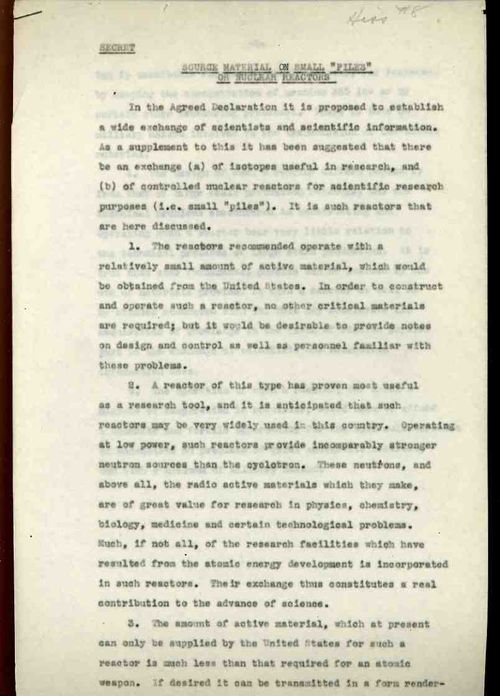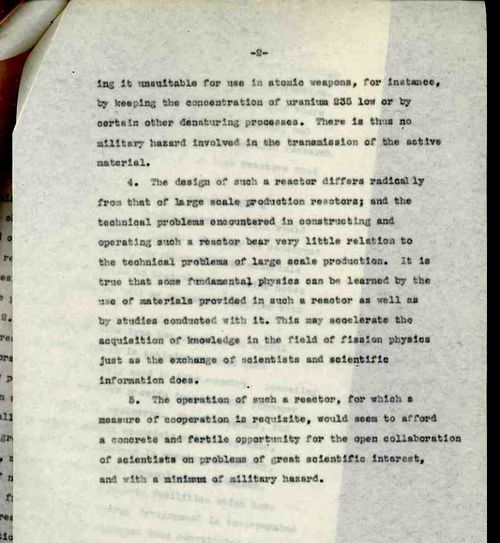JF Ptak Science Books LLC Post 489
 This paper is one from a small archive of background and draft papers and
proposals by the Vannevar Bush group working on the question of the control of
atomic weapons and the formalization of the American position regarding the use
and control of atomic weapons, October 1945-February 1946. This archive
consists of 38 documents relating to the development of U.S. atomic policy,
with contributions by President Harry Truman, Secretary of State James Byrnes, Dr. Vannevar
Bush, (future AEC director) Carroll Wilson, Alger
Hiss, I.I. Rabi,
William Shockley,
Frederick Dunn, Joseph E. Johnson, Leo Pasvolsky, Philip Morrison, Col.
Nichols, William McRae, Admiral W.H.P. Blandy, George L. Harrison, and
others.
This paper is one from a small archive of background and draft papers and
proposals by the Vannevar Bush group working on the question of the control of
atomic weapons and the formalization of the American position regarding the use
and control of atomic weapons, October 1945-February 1946. This archive
consists of 38 documents relating to the development of U.S. atomic policy,
with contributions by President Harry Truman, Secretary of State James Byrnes, Dr. Vannevar
Bush, (future AEC director) Carroll Wilson, Alger
Hiss, I.I. Rabi,
William Shockley,
Frederick Dunn, Joseph E. Johnson, Leo Pasvolsky, Philip Morrison, Col.
Nichols, William McRae, Admiral W.H.P. Blandy, George L. Harrison, and
others.
I have written elsewhere
on this site about Vannevar Bush (not related to the outgoing) and the coming atomic/nuclear arms problem--as
perhaps one of the pre-eminent scientific minds in the Roosevelt/Truman
administrations, Bush and others foresaw the development of the atomic arms
race in 1943, and by 1945 Bush became a fundamental thinker and advocate
on the problem. The items in this archive are low-formal background papers,
drafts of proposals, informal studies, as well as mature statements of thought
that would become implemented in the core of
The former owner of this framework, Alger Hiss (Baltimore-born, 1904-1992) is primarily known for one generation as being accused of being a Soviet spy, and by another generation (mine) for defending himself for the rest of his long life against those charges. (As it turns out in the small-world department, during WWII Hiss lived six doors away from my Georgetown store on Volta Street--the street so-called because Alex Bell's "Volta Bureau" was perched at its head.) I suspect that the current generation doesn't know his name at all--his crime belongs to another time, but the execution of his prosecution is one of those botched and troublesome things that long outlive the subject as an example of how not to do things, and also about things that just shouldn't be done. He was tried (twice) for espionage right after WWII and spent 44 months in Lewisburg Federal Prison from 1949 to 1952--he wasn't convicted on espionage charges, though; he was found guilty of some relatively serious perjuries, but nothing really to convince a reasonable jury that he was a Soviet tool. His principal accuser, Whittaker Chambers, is at best problematic element, pulling himself in many different ways through his curdled memory of Hiss' affairs. The post-Soviet record (according to former KGB agents' testimonies, project VERONA and the like) of Hiss' story are also confusing and somewhat misleading and work at odds, some of the sources confirming his existence as a spy, others offering exculpatory evidence and pointing to another man. It seems that after everything is said and done that he was probably not guilty of the espionage charges, and that he was a victim of the forces feeding the ravenous appetite of HUAC (House Un-American Affairs Committee), a sensory-blunted beast that consumed many people through little more than fear. (The loathsome Richard Nixon was one element of this drama--he was a young Congressman from California who used the skulls of the people he wantonly bullied and ruined to reach the lowest rungs of his political ladder to success. Yes, the man was rotten all the way down.)
Back to the paper--in 1945, when this paper was written, Hiss was a delegate to the Yalta Conference, which was also primarily involved in the planning of postwar Europe. The main concern of the Bush group was to create an environment in which the coming development of nuclear weapons by the Soviet Union could be at least understood--the greater goal in this work was the control of the proliferation of these weapons,m but I think that everyone involved knew that this was a hopeless issue. To this end the group looked at different ways in which newly-created agencies in the brand-new United Nations could somehow serve as a distiller of information and also, improbably, as a policing force. Again, it was very widely recognized by the members of the Bush group that the Soviet Union would have the Bomb in short order: the educated guess by the members was from three years following the war, to ten (somewhere between 1948 and 1955).
The authorship of this paper, "Source Material on Small 'Piles' or Nuclear Reactors" is not acknowledged, though there are two reasonable guesses about who this might be. FIRST: my guess is that it may be the work of Philip Morrison. This guess is good if and only if ("iff") we limit the possible authorship to only those people in the Bush group; if not, my bet is off. SECOND: if this paper was written by an 'outside" member, then it may very well be the paper referenced in the American Philosophical Society's Henry DeWolf Smyth (who I've written about earlier) archive as an unpublished work by Smith himself--there is a paper there by the same very uncommon title, and said to have been intended for the State Department, and dated December 1945. Hiss was working for State at the time, so this very well may be the best fit.And of course Smyth is the author of the official history of the making of the atomic bomb, Atomic Energy for Military Purposes; The Official Report on the Development of the Atomic Bomb under the Auspices of the United States Government, 1940-1945. Smyth is definitely the best fit but for the exception of there being no others papers in this archive that were not the product of a Bush group member. (This could be simply solved if it was possible to here the first sentence of the APS paper but I have not been able to do so. This material also doesn't seem to be in the Smyth book, though the prime candidate for its inclusion would've been in chapter four, the entire text located at the excellent Atomicarchive.com site.) The odds-on favorite here though is for Smyth. The paper is a carbon copy of the typed original; Hiss' name (along with #8) is written in pencil at the top right; it is possible to pound your way through eight layers of onion-skinned carbon paper, but probably not much more. Hiss was probably one the bottom of the list to receive this summary--at least that's my guess. the paper is only two pages long so it is reproduced in full and from what I can determine for the first time.
For the topic it covers and for the brevity of the paper, it is a very well-written account of the military value of small nuclear reactors (or "piles")--that is to say the author correctly identifies the military threat value for a research-grade reactor as low ("a minimum of military hazard") while the consequences for advancing scientific knowledge as a result of the use of these reactor would be quite high. In short this little paper outlines what would be the general opinion of teh U.S. government regarding the proliferation of small nuclear reactors, and would function in much the same way as the large Smyth report, settin gthe limits of acceptable and prohibited information and technology.




Comments